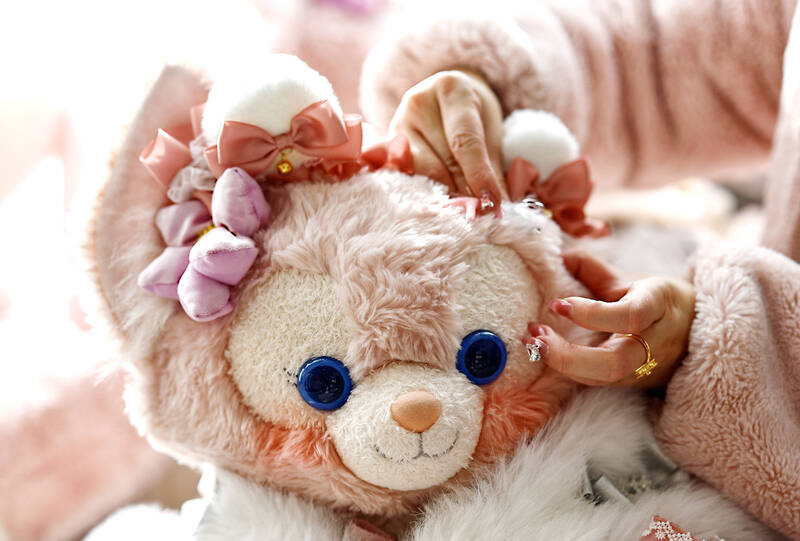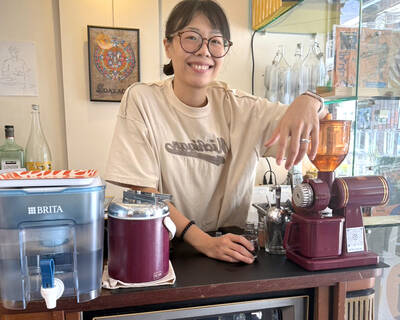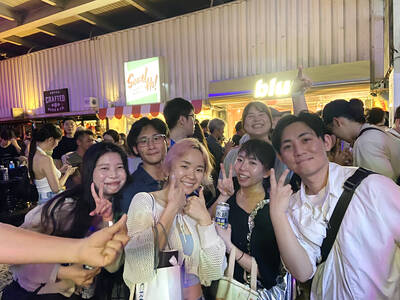Each week, whenever she has time off from her marketing job, Ida Jia can be found at Shanghai Disneyland queuing for hours to spend a few minutes with Linabell, a fluffy pink fox with big blue eyes.
The 29-year-old does not go empty handed, bringing pink fox soft toys dressed in ornate custom-made outfits to show the life-sized character, as well as handmade presents as gifts.
Linabell, which made its debut in Shanghai in 2021, is helping Disney benefit from a rapidly growing market in China for merchandise related to toys, games, comics and anime, which remained popular with teenagers and young adults throughout the last year, even as they reduced spending on items from beauty products to luxury handbags.

Photo: Reuters
The phenomenon has been dubbed “emotional consumption” in Chinese state media, and has been likened to the so-called “lipstick effect” in which consumers seek out more affordable luxuries as the economy languishes.
Jia first met Linabell at Shanghai Disneyland three years ago and says she felt an immediate connection with the character. In the years since, she has transformed her home and bedroom with Linabell merchandise.
“She has a positive influence on me, feeling her cuteness and energy is very soothing,” she said during a recent trip.

Photo: Reuters
Jia is far from alone in China in her devotion to Linabell, which has gained a large following since it was created as part of the Duffy and Friends series of characters — which also includes teddy bears, a bunny and a turtle.
Linabell, which has since been introduced at parks in Hong Kong and Tokyo, is arguably Disney’s most popular character in China, attracting at least as many fans as Mickey or its Disney princesses. Many adults, mainly young women, join daily queues to see Linabell, wanting to get a hug and take home a selfie as a souvenir from their day at Disney.
Alongside Linabell and Duffy and Friends, which have their own dedicated boutiques inside Shanghai Disneyland, others that are benefiting from the trend include collectible toy brands such as Jellycat and Chinese blind box toy retailer Pop Mart whose Labubu rabbit-like character sparked a global craze.
“They are filling an emotional void, the products are there to remind themselves that you can be happy about the little things in life,” said Yaling Jiang, founder of research and strategy consultancy ApertureChina.
“I do believe it’s related to the economy.”
According to Sami Wong, a psychotherapist and managing director of 3Drips Psychology, a research firm, the growth of emotional consumption in China is also part of the evolution in younger consumers’ behaviour away from purchasing goods simply as a status symbol.
“It’s really about understanding themselves and how to get in touch with their internal needs so they can establish an identity that feels consistent and coherent with their sense of self,” she said.
Xia Sansan, 28, along with her husband Rooney Sheng, are the proud owners of what they believe is the world’s largest collection of Duffy and Friends merchandise, having bought every single item released by Disney in Shanghai, Hong Kong and Tokyo.
Their 100-square-metre apartment in Shanghai is crammed with their collection of thousands of toys arranged in floor-to-ceiling cabinets, alongside racks of headbands, bags, keychains and more. Xia estimates they have spent more than 1 million yuan (US$136,000) in total.
“I mainly consider the emotional value when I consume,” Xia said.
“The value comes from seeing so many dolls at home every day, which makes me very happy, it’s this kind of healing feeling,” Sheng added.
Yasmeen Chen, creative director of merchandise at Shanghai Disney Resort and part of the team that created Linabell, said the character’s popularity had exceeded their expectations and that she had the potential to find success beyond Asia.
“These days everyone is looking at their phones and using computers; the interaction between people is less and sometimes there may be less companionship with parents, friends or family,” she said.
“I think in this regard, Linabell and Duffy and Friends provide a lot of emotional value.”

Cheng Ching-hsiang (鄭青祥) turned a small triangle of concrete jammed between two old shops into a cool little bar called 9dimension. In front of the shop, a steampunk-like structure was welded by himself to serve as a booth where he prepares cocktails. “Yancheng used to be just old people,” he says, “but now young people are coming and creating the New Yancheng.” Around the corner, Yu Hsiu-jao (饒毓琇), opened Tiny Cafe. True to its name, it is the size of a cupboard and serves cold-brewed coffee. “Small shops are so special and have personality,” she says, “people come to Yancheng to find such treasures.” She

In July of 1995, a group of local DJs began posting an event flyer around Taipei. It was cheaply photocopied and nearly all in English, with a hand-drawn map on the back and, on the front, a big red hand print alongside one prominent line of text, “Finally… THE PARTY.” The map led to a remote floodplain in Taipei County (now New Taipei City) just across the Tamsui River from Taipei. The organizers got permission from no one. They just drove up in a blue Taiwanese pickup truck, set up a generator, two speakers, two turntables and a mixer. They

Former Chinese Nationalist Party (KMT) chairwoman Hung Hsiu-chu’s (洪秀柱) attendance at the Chinese Communist Party’s (CPP) “Chinese People’s War of Resistance Against Japanese Aggression and the World Anti-Fascist War” parade in Beijing is infuriating, embarrassing and insulting to nearly everyone in Taiwan, and Taiwan’s friends and allies. She is also ripping off bandages and pouring salt into old wounds. In the process she managed to tie both the KMT and the Democratic Progressive Party (DPP) into uncomfortable knots. The KMT continues to honor their heroic fighters, who defended China against the invading Japanese Empire, which inflicted unimaginable horrors on the

Hannah Liao (廖宸萱) recalls the harassment she experienced on dating apps, an experience that left her frightened and disgusted. “I’ve tried some voice-based dating apps,” the 30-year-old says. “Right away, some guys would say things like, ‘Wanna talk dirty?’ or ‘Wanna suck my d**k?’” she says. Liao’s story is not unique. Ministry of Health and Welfare statistics show a more than 50 percent rise in sexual assault cases related to online encounters over the past five years. In 2023 alone, women comprised 7,698 of the 9,413 reported victims. Faced with a dating landscape that can feel more predatory than promising, many in